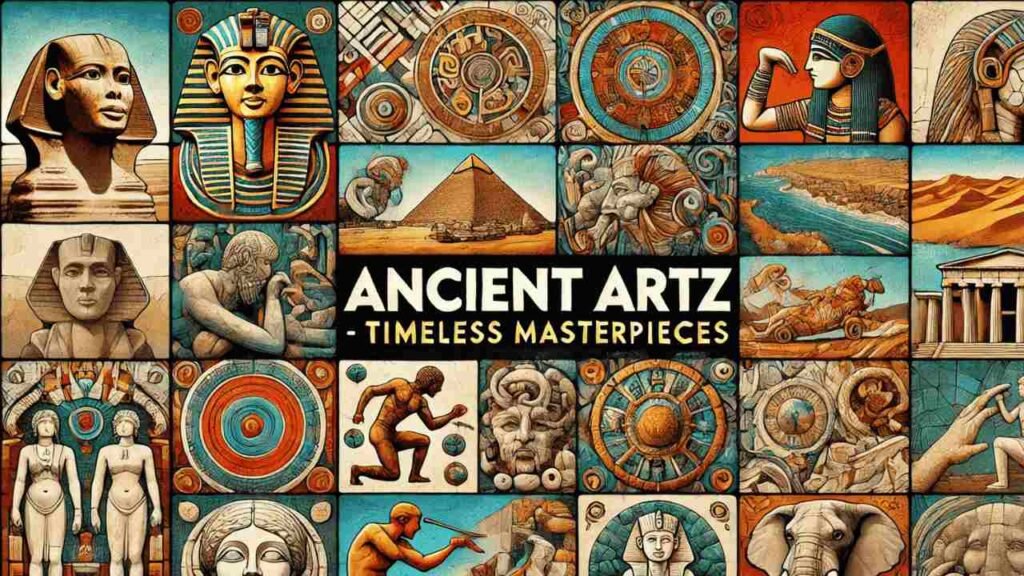Ancient art, often referred to as “ancient artz,” encompasses the creative works produced by early human societies. This includes paintings, sculptures, architecture, and decorative arts from ancient cultures such as Egypt, Greece, Rome, China, and others. These artworks provide valuable insights into the beliefs, daily lives, and technological advancements of our ancestors.
Historical Facts and Figures
| Category | Fact/Figure |
| Earliest Known Artwork | Cave paintings from Chauvet Cave in France, dated around 30,000 BCE. |
| Oldest Sculpture | The Venus of Willendorf, a limestone figurine from 25,000 BCE, found in Austria. |
| Ancient Egyptian Art | Egyptian art flourished around 3,000 BCE with the rise of the Old Kingdom. |
| Number of Terracotta Warriors | Approximately 8,000 life-sized warriors discovered in the tomb of Emperor Qin Shi Huang (China). |
| Greek Sculptures | Classical Greek sculptures emerged during the 5th century BCE, focusing on ideal human form. |
| Roman Mosaics | Mosaics became popular in Rome during the 2nd century BCE, with intricate designs in homes and public spaces. |
| Mesopotamian Ziggurats | The Ziggurat of Ur, built around 2100 BCE, stands at 70 feet (21 meters) tall. |
| Mayan Art | Mayan murals were created around 1000 BCE in Mexico and Guatemala, depicting gods and celestial events. |
| Indus Valley Civilization Art | The Indus Valley, active from 3300–1300 BCE, produced detailed pottery and bronze figurines. |
| African Rock Art | Saharan rock art is estimated to be around 8,000 years old, found in regions like Algeria. |
| Hieroglyphics | Ancient Egyptian hieroglyphics date back to 3,200 BCE and contain over 700 symbols. |
| Olmec Colossal Heads | The Olmec heads, weighing up to 50 tons, were carved between 1200 and 400 BCE. |
| Stonehenge | Built in 2500 BCE in England, Stonehenge features large stones weighing up to 25 tons each. |
| African Wooden Sculptures | African wooden art flourished between 500 BCE and 1000 CE, with sculptures used in spiritual rituals. |
| Roman Public Art | Rome’s Colosseum, completed in 80 CE, featured sculptures and art to honor emperors and deities. |
What is Ancient Artz?
Ancient artz refers to the artistic creations of early civilizations, including:
- Paintings: Visual representations on surfaces like cave walls, pottery, and canvases.
- Sculptures: Three-dimensional artworks carved from materials like stone, wood, or metal.
- Architecture: Design and construction of buildings and structures, often with artistic elements.
- Decorative Arts: Artistic objects that are both functional and decorative, such as pottery, jewelry, and textiles.
These creations served various purposes, from religious rituals to daily utility, and reflect the cultural values of their time.
Examples of Ancient Artz
Here are some notable examples of ancient artz:
- Cave Paintings: Early humans created paintings of animals and human figures on cave walls, such as those found in Lascaux, France.
- Bust of Nefertiti: A renowned sculpture from ancient Egypt, representing Queen Nefertiti with remarkable realism.
- Syracusan Medals: Ancient Greek coins known for their intricate designs and craftsmanship.
- Battle of the Magnesians: Historical depictions of this significant battle, showcasing ancient military art.
- Statue of Zeus Base Reliefs: The base of the Statue of Zeus at Olympia featured detailed reliefs illustrating various mythological scenes.
Regions Rich in Ancient Artz
Ancient artz flourished in various regions, each contributing uniquely to the global artistic heritage:
- Ancient Near East: Encompassing Mesopotamia, Persia, and surrounding areas, known for ziggurats and intricate reliefs.
- Egypt: Famous for monumental pyramids, temples, and tomb paintings.
- Indus Valley Civilization: Noted for advanced urban planning and artifacts like seals and pottery.
- China: Home to ancient bronzes, jade carvings, and early calligraphy.
- Greece: Celebrated for sculptures, pottery, and architectural orders like Doric and Ionic.
- Celtic: Known for intricate metalwork and stone carvings.
- Rome: Renowned for engineering feats, mosaics, and realistic portraiture.
- Germanic: Featuring wood carvings, metalwork, and runic inscriptions.
Considerations When Acquiring Ancient Artz
If you’re interested in collecting ancient artz, keep the following points in mind:
- Condition of the Item: Assess the preservation state; restoration may affect value.
- Expert Consultation: Seek professionals for restoration, storage, mounting, cleaning, or repairs.
- Legal Acquisition: Ensure the piece has been obtained and exported legally to avoid illicit trade.
The Role of Ancient Artists
In ancient societies, creators of art were often regarded as artisans or craftsmen rather than artists in the modern sense. Their work was typically functional or commissioned for religious and state purposes. For example:
- Egyptian Artisans: Produced tomb paintings and sculptures to honor deities and pharaohs.
- Greek Sculptors: Created statues of gods and athletes, emphasizing idealized human forms.
- Roman Mosaists: Designed intricate floor and wall mosaics depicting scenes from mythology and daily life.
Prehistoric Art: The Dawn of Creativity
Before written records, prehistoric art provides a glimpse into early human expression:
- Cave Paintings: Depictions of animals and hunting scenes, possibly for ritualistic purposes.
- Petroglyphs: Rock engravings found worldwide, representing symbols and figures.
- Venus Figurines: Small statues of female figures, suggesting fertility symbolism.
Recent Discoveries in Ancient Artz
Archaeological efforts continue to unearth significant artifacts:
- Pompeii Frescoes: Recent excavations have revealed well-preserved frescoes depicting Dionysian rituals, offering insights into Roman religious practices.
- Chinese Artifacts: Thousands of items, including Qing dynasty lacquer panels, are being restored and displayed, reflecting China’s rich artistic heritage.
The Future of Ancient Artz
While ancient artworks were created thousands of years ago, their influence continues to shape modern art and culture. Digital preservation, museum exhibitions, and ongoing archaeological discoveries ensure that future generations can appreciate and learn from these timeless masterpieces.
Conclusion
Ancient artz serves as a bridge connecting us to early civilizations, offering insights into their cultures, beliefs, and daily lives. By studying these artworks, we gain a deeper appreciation for human creativity and the shared heritage that shapes our world today.
Frequently Asked Questions:
Q1: What materials were commonly used in ancient artz?
Ancient artists utilized materials such as stone, clay, metals, and natural pigments derived from minerals and plants.
Q2: How were ancient artworks preserved over time?
Many artworks survived due to durable materials and favorable environmental conditions, while others were preserved through deliberate efforts like burial in tombs.
Q3: Can ancient artz still be found today?
Yes, ongoing archaeological excavations continue to uncover ancient artworks, and many pieces are displayed in museums worldwide.
Q4: What is the significance of studying ancient artz?
Studying ancient artz helps us understand the cultural, religious, and social aspects of early civilizations, enriching our knowledge of human history.
Q5: How can I learn more about ancient artz?
Visiting museums, reading scholarly articles, and exploring reputable online resources can provide extensive information on ancient artz.
Note: You can find more informative Articles at Influencersginewuld.

